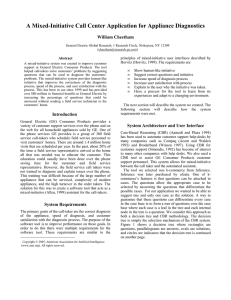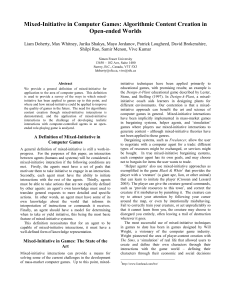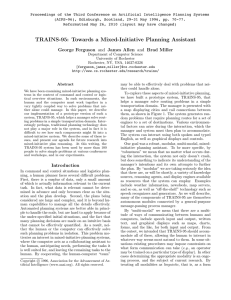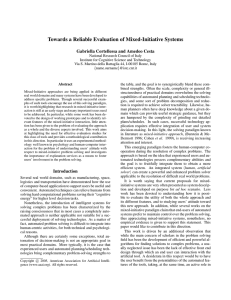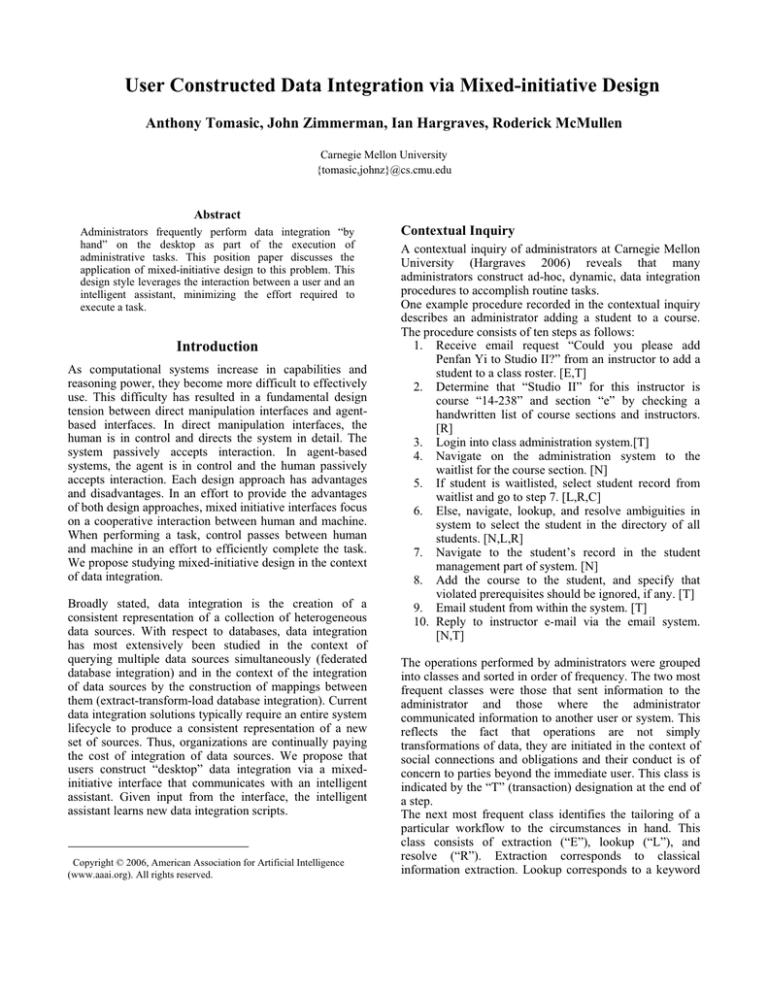
User Constructed Data Integration via Mixed-initiative Design
Anthony Tomasic, John Zimmerman, Ian Hargraves, Roderick McMullen
Carnegie Mellon University
{tomasic,johnz}@cs.cmu.edu
Abstract
Administrators frequently perform data integration “by
hand” on the desktop as part of the execution of
administrative tasks. This position paper discusses the
application of mixed-initiative design to this problem. This
design style leverages the interaction between a user and an
intelligent assistant, minimizing the effort required to
execute a task.
Introduction
As computational systems increase in capabilities and
reasoning power, they become more difficult to effectively
use. This difficulty has resulted in a fundamental design
tension between direct manipulation interfaces and agentbased interfaces. In direct manipulation interfaces, the
human is in control and directs the system in detail. The
system passively accepts interaction. In agent-based
systems, the agent is in control and the human passively
accepts interaction. Each design approach has advantages
and disadvantages. In an effort to provide the advantages
of both design approaches, mixed initiative interfaces focus
on a cooperative interaction between human and machine.
When performing a task, control passes between human
and machine in an effort to efficiently complete the task.
We propose studying mixed-initiative design in the context
of data integration.
Broadly stated, data integration is the creation of a
consistent representation of a collection of heterogeneous
data sources. With respect to databases, data integration
has most extensively been studied in the context of
querying multiple data sources simultaneously (federated
database integration) and in the context of the integration
of data sources by the construction of mappings between
them (extract-transform-load database integration). Current
data integration solutions typically require an entire system
lifecycle to produce a consistent representation of a new
set of sources. Thus, organizations are continually paying
the cost of integration of data sources. We propose that
users construct “desktop” data integration via a mixedinitiative interface that communicates with an intelligent
assistant. Given input from the interface, the intelligent
assistant learns new data integration scripts.
Copyright © 2006, American Association for Artificial Intelligence
(www.aaai.org). All rights reserved.
Contextual Inquiry
A contextual inquiry of administrators at Carnegie Mellon
University (Hargraves 2006) reveals that many
administrators construct ad-hoc, dynamic, data integration
procedures to accomplish routine tasks.
One example procedure recorded in the contextual inquiry
describes an administrator adding a student to a course.
The procedure consists of ten steps as follows:
1. Receive email request “Could you please add
Penfan Yi to Studio II?” from an instructor to add a
student to a class roster. [E,T]
2. Determine that “Studio II” for this instructor is
course “14-238” and section “e” by checking a
handwritten list of course sections and instructors.
[R]
3. Login into class administration system.[T]
4. Navigate on the administration system to the
waitlist for the course section. [N]
5. If student is waitlisted, select student record from
waitlist and go to step 7. [L,R,C]
6. Else, navigate, lookup, and resolve ambiguities in
system to select the student in the directory of all
students. [N,L,R]
7. Navigate to the student’s record in the student
management part of system. [N]
8. Add the course to the student, and specify that
violated prerequisites should be ignored, if any. [T]
9. Email student from within the system. [T]
10. Reply to instructor e-mail via the email system.
[N,T]
The operations performed by administrators were grouped
into classes and sorted in order of frequency. The two most
frequent classes were those that sent information to the
administrator and those where the administrator
communicated information to another user or system. This
reflects the fact that operations are not simply
transformations of data, they are initiated in the context of
social connections and obligations and their conduct is of
concern to parties beyond the immediate user. This class is
indicated by the “T” (transaction) designation at the end of
a step.
The next most frequent class identifies the tailoring of a
particular workflow to the circumstances in hand. This
class consists of extraction (“E”), lookup (“L”), and
resolve (“R”). Extraction corresponds to classical
information extraction. Lookup corresponds to a keyword
based database query. The “resolve” operation refers to
reference resolution. For example, in step 2 above, the
administrator uniquely identifies a course and section. Note
that all three operations translate unstructured information
into a structured form. Finally, navigation (“N”) and
conditions (“C”) complete the set of operations performed.
Once in a structured form, the intelligent assistant can
execute the workflow. Note that these operators are
precisely those that are concerned with shaping data
integration to the circumstances of its use. To assist the
user in constructing workflows from these operators, we
have designed a mixed-initiative interface, illustrated
above.
Conclusion
In this position paper we outlined the result of a contextual
inquiry that documents data integration tasks performed
manually on the desktop. We proposed to support data
integration through mixed-initiative design for intelligent
assistants. To better understand the intelligent assistant
aspect of our vision, we have constructed two prototypes.
The Virtual Information Officer (Zimmerman, Tomasic,
Simmons, 2007) analyzes e-mail messages and presents
pre-filled forms that assist the user in processing the
message. Workflow by Example (Tomasic, McGuire,
Myers, 2006) constructs workflow scripts by observing
demonstrations of workflows generated by the user. Future
work will focus on constructing the intelligent assistant
user constructed data integration tasks.
Acknowledgements
This material is based upon work supported by the Defense
Advanced Research Projects Agency (DARPA), through
the Department of the Interior, NBC, Acquisition Services
Division, under Contract No. NBCHD030010, Delivery
Order No. D0300100003.
References
Ian Hargraves, 2006. Report on Design Investigations for
User Constructed Workflows, Unpublished Manuscript.
Anthony Tomasic, R. Martin McGuire, Brad Myers, 2006.
Workflow By Example: Automating Database Interactions
via Induction, Carnegie Mellon University Technical
Report Nr. CMU-ISRI-06-103.
John Zimmerman, Anthony Tomasic, Isaac Simmons, Ian
Hargraves, Ken Mohnkern, Jason Cornwell, Robert
McGuire, 2007. VIO: a mixed-initiative approach to
learning and automating procedural update tasks, CHI
2007, San Jose, CA.








